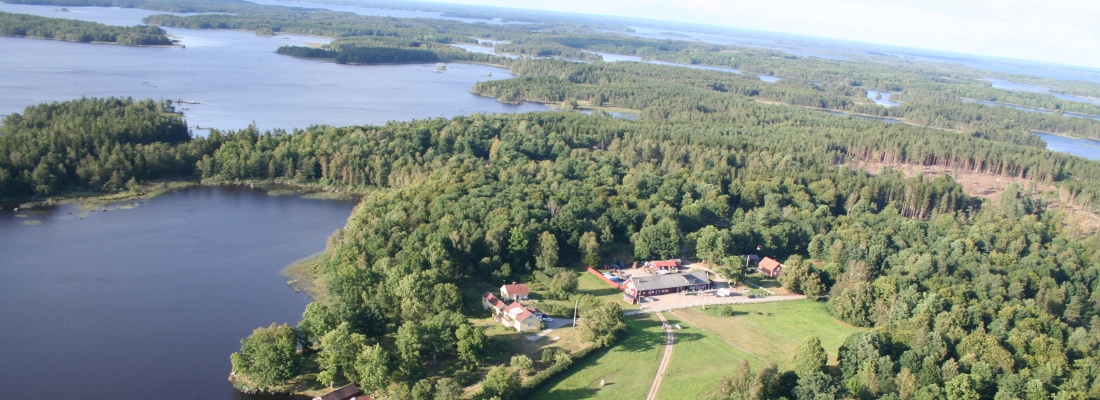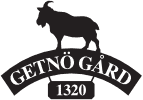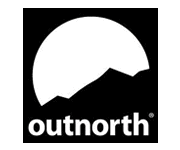
Getnö – a tourist paradise with roots from the past
Getnö Farm has a colourful and fascinating history, with its roots stretching deep into the past. When the inland ice melted 14.000 years ago, an enormous amount of water crushed into gravel and sand. The oldest relics from this period can still be seen on Getnö. The island is a four kilometers long gravel ridge that stretches across the entire island and other interesting gravel formations. To protect these relics for the future, the present owners, the Olsson Family, formed a privately owned nature reserve, which prohibits the excavation of gravel. Mostly, it is the stones in the area that remind us of the days gone in Getnö. Cairns from the Bronze Age can also be seen adjacent to ancient fossil fields. The island includes stone foundations after wind turbines and settlements from different periods, grave mounds, stone circles, stone cists and stonewalls. The earliest known documentation relating to Getnö dates back to the year 1320. Natural evidence and ancient relic discoveries are registered proof that people lived on Getnö as far back as the Stone Age, 6000 B.C.
Hunting and fishing
The nomads where the first to stay here, living from fishing and hunting. There were plenty of wild reindeer in the area. As the climate became milder they started to cultivate the ground, also acquired animals. Lake Åsnen was then as it is today good fishing ground, there was also an abundance of game and also wild berries of different sorts, this of course meant that there was a good chance for survival. Slowly small villages were built. Under the later part of the stone age 3500 – 1800 B.C. Getnös inhabitants became resident farmers. The care of the cattle became more efficient as so did the farming. They even started to sow and grow grain. The woods became grazing ground for the cattle. Stone mounds and graves witness that there were permanent farms on the island at this time. They went on to open new ground with help of burn beat and then hacking the earth. The new time had made itself known even on Getnö in lake Åsnen. A sort of barter transaction was started, but it also brought in sickness and even miss growth only the strongest survived. It was a tough generation who lay these districts under the plough.
Iron and coal
From the bronze age 1800 – 500 B.C. there are many discoveries on Getnö that can tell how life was there, at that time. It was from this time the so called fossil stone mounds originates, there are many of the on the island. It proofs that many families had their livelihood here and also that there was an abundance of game and fish. On the poor earth they kept goats, therefore the name Getnö which means goat fodder. Under the older iron age 500 B.C. – 500 A.D. people started to make iron. The raw material came from the lakes and mine ores, which made life easier even on Getnö. They made tools and weapons of metal. And they started to produce charcoal and wood to build houses. Travelling tradesmen started to come from further and further away. Danes and Germans ventured up the Småland border. They had goods, new ideas and impulses from foreign lands as far as the Roman Empire.
Vikings then and now
The Viking Age 800-1100 A.D. made the Scandinavians internationally known as far as the Arab world and Russia. The Vikings came as traders, but often with a sword in hand. The people from Småland sold skins and tar. Many returned with well filled ships. Many never returned. To live on a border line as Getnös inhabitants did, could sometimes be worrying, but as they lived on an island they were often spared. Round about them newly built churches were burnt down, farms even whole villages were destroyed by the Danish Vikings who were nearby. The people however survived quite well. We can find that there was no bigger catastrophe.
Smuggling and execution
Getnö has an interesting owner length. We can pick just a few names from this colourful history. The first mentioned owner year 1320 was the knight Håkan Läma, who was forced from Getnö and had to leave it to the bishop of Växjö after a trial. Håkan was even sentenced to be beheaded. The year 1457 Getnö was once again in private hands, squire Bengt Giseson (Två Strömmar/ Two Streams) gave his bride Iliana Gudmundsdotter (Grönalöf / Green Leafs) the property as a morning gift on their weddingday. Next time something drastic happens on Getnö is in the year 1552, when the owner Måns Olsson has relinquish the island and farms to the king Gustav Wasa. Måns was accused of smuggling and border trade which was forbidden and he became beheaded. After a time Getnö became the kings farm and the nobilities farm for 250 years. After a time the kings farm Getnö became an estate and was donated to lower nobility until 1804 when it was purchased by three commoner farmers. But ownership was often short while it was unstable in the outside world and one after another of the farm owners fell in battle during unsettled times. Getnö became somewhat of a widows farm.
A wild life
1639 colonel Lindorm Ulfsax the younger was the owner of Getnö. He owned 130 farms, but all of them included Getnö were lost, due to his way of life with women and gambling. 1639 he was forced to leave Getnö and he was executed soon after. Another colourful person on Getnö was Marcus Marcusson who bought the farm 1854. He was a contractor almost close to modern time. He went to London and bought a steam engine to operate a saw mill on Getnö. It was brought back on a steamship via Liverpool and Karlshamn, last step was pulled by oxen to Getnö. The transport took two months. Unfortunately time had passed so quickly for him an the investment had no success as he was hoping so he went backruptcy. But he was not like his descendents misfortune from 1320, 1552 and 1639 , beheaded.
Two crofters destiny
We are now stepping into modern times, there are still people alive who can relate to the people who lived on Getnö. A Carl Jonasson lived in the 19th century and lived in Stommare Croft. He was a shoemaker and had a Sunday assignment which was on top of his everyday work. He had to make two pairs of clogs then row the boat to Urshults church. The year 1895 Carl Jonassons son Joel took over, but 1905 he emigrated to America, his wife followed five years later. Karl Johanneson and his wife Agda had six children. They were a crofter family on Lunnatorpet, it was a small croft and they were very poor. Agda begged for food, once she asked the squire for bread but he denied her this. His housekeeper however felt sorry for her and sent a maid, when it was dark with a loaf of bread. Agda was known for her strength she carried a slaughtered calf to Ålshults country shop. For the money she bought provisions and on one occasion she bought a harrow and carried it all the way home, which was seven kilometres.
Time of the wolfs
There are stories from this time about dangerous wolfs were for Getnö inhabitants in every day life. The church books in Småland tell how many where attacked by wolfes. A winter day 1845 Squire Masse and his farm hand, went to fetch water for the tub. They took a horse and cart down to lake Åsnen which was frozen. There they were confronted by a pack of wolfs, the horse frightened and galloped with the cart back to the stable. The wife saw this and became worried and asked the old man Petter to get his shot gun and then sent him to see what had happened. At first he found nothing but then he saw traces of blood, he knelt down and started to pray, but suddenly he heard his masters voice loudly calling "we are alive"! We hid under the empty tub, one of the wolfs tried to get at us andput both his paws under the tub and we were able to chop of the wolfs paws and when the other wolfs smelt blood they attacked and killed the paw less wolf. Then after a good meal they were satisfied and left. "We thank God for that!"
Five farms became two and then one
Getnö had several farms for a long time. Getnö itself had three small farms and Vrigstad, that lies on a peninsula next to Getnö had two farms. After the distribution 1813 Getnös fusion and Vrigstad fusion meant that each had its own owner. On Getnö the owner was August Marcusson squire and on Vrigstad his brother Erik. The turn of the century nothing had changed, the farms were isolated and modernisation went slowly, superstition and old customs still lingered. Even in the 20th century flax was cultivated and wool was spun and woven. Grain was transported by boat to the mill in Horjeboda and the flour the same way back. Vrigstad at this time owned half of the mill. Earlier it must be ground by hand. The hand mill can be seen at the Farm museum. There are no windmills left on the island although they were here 1320. During the winter transport was easier as they could go over the ice. 1870 the railway between Karlshamn and Vislanda was at last ready and this menat a loft for the whole district. Oxens were taken over by horses and modern equipment which mad it easier to transport goods to the railway. Vrigstad was the last farm in this area that still had oxen, one could see them working as late as 1920.
Haunted
There was a generation change at Vrigstad. Eriks children took over. Two of them left the district, one called Amanda left for America others broke out and bought their own farms. The youngest son Olof remained on the farm and runs it togehter with his brothers and sisters and a niece Edith. Olof slowly settles economical with all of them. He made a lot of money from fishing on lake Åsnen. The last one of the family settled with in the 1950’s for 65 000 an enormous amount of money. At the same time his sister Anna won 100 000 on a lottery. She used it to build a house. Today it is called Farmorstugan (Grandmother house). She and her brothers and sisters planned to live there when Olof got married. But suddenly Olof realised that if he got married he would loose hes good and cheap labour. So he changed his mind about marriage and took superstition as help. He told Anna that her house was haunted. Nobody believed him and just laughed at him, they prepared for the first night in the house. Six oclock the next morning all sisters and brothers stod outside Vrigstad and begged Olof to let them in. All agreed that they could not live in the house, Olof was right, the house was haunted. It is said that Olof secretly smiled, but he never admitted that he had anything to do with it. Annas house stood emptyu for 23 years till it was sold to cantor Ingmar tysk 1969. Then the house was bought by Lennart Olsson 1982.
The sale of Getnö
August Marcusson’s six children disagreed on who was to inherit Getnö, so it was lost from the family. It was bought 1938 by Sven Hallen Schwartz, who was of German origin. He once owned a rubber plantation and moved in with his Danish wife countess Leila. The new owners repaired buildings and also built a house for a foreman.. They even put up something so newfangled as a wind driven electric power station. They were a very well liked and generous couple that lived on Getnö a few years. 1944 consul Inge Erichs from Malmö bought Getnö. He had in mind to use it as a summer residence, most of the year his son lived there. During Erichs time they put in electricity from the main land and also a telephone. During this time 1944-47 a Gunnar Johansson on Igelön was the lease holder for Getnö and there where three professional fishers on the farm.
New times
We have now arrived in 1967 when Lennart Olsson became the owner to Getnö Gård. 1971 he bought Vrigstad from Olof and Anna Marcusson and both of the farms became one Now a new epoch in the history of Getnö begins. Farming and forestry was stepped up with the help of large investments. A new road of five kilometres and three bridges were made. The old road between Ålshult and Getnö was repaired by the new owner and all houses were renovated. As most there were four horses, two tractors, 100 sheep, hens and 60 charolais cows and calves. This was all run by the foreman Gunnar Svensson. In the spite of great achivement from the foreman couple Gunnar and Doris together with the owners it became difficult to make a profit. Lennart Olsson started to look around for other possibilities for his beautifully situated farm and he fastened for tourism. Getnö had all the qualifications to become a paradise for nature lovers and sport fishing. The barn was rebuilt and made into reception, kiosk, café, restaurant, a small food shop, conference rooms and a pub. Many houses were also renowated and rented out to tourists. The smallest for 2 persons, the largest for 18-20persons. A very interesting farm museum was developed and all the ancient findings are on display. A canoebase in Ålshult was started and the naturcampingplace on Getnö had 120 places. Investments in motorboats and canoes were made. The canoeroute Värendleden started in the beginning of 1980’s, 120km long to paddle for canoers. A system with tourist/canoecampingchecks that give service to overnighting canoeists started 1990. It has helped canoe tourism to proceed and other advantages for the landowners in the sparsely populated area around the watersystems. Lake Åsnen with its rich fishingwaters is very attractive and Getnö is member of Top-10-Fishing areas in Sweden. Lennart Olsson was chosen the sportfishing contractor of the year 1999 by the Swedish Fishingdepartment, the Tourist Delegation and the Tourist Council.
An oasis
In a time like ours, people are stressed, at Getnö gård we try to give people an experience of the nature and a chance to relax. This can be done if serveral ways. For those who just want to enjoy the wonderful scenery and outside life there is a wide choice. Getnö has fantastic variations of birds, wild life and flora. The private nature reserve was founded to protect wild life, flora and bird life for the coming generations.
In 1995, Ingrid Olsson (the daughter of Lennart Olsson) started to work with the tourism business and developed the conference centre. Outdoor- and Teambuilding activities started on Getnö Gård. Conference guests from both near and far are coming.
In 2003 Ingrid Olsson and her father Lennart Olsson received the price as the top Tourist-entrepreneurs of the year 2003 in south Småland.
In 2007, there was a 100year jubileum on Getnö Gård. The farm was 40 years in the Olsson family and Lennart and his wife Gunnie Olsson celebrated 60 years anniversary on 19/7-2007. A big celebration with family, friends and guest from different countries.
In 2010 the estate is divided between the 4 children of Lennart Olsson. Ingrid Olsson continues with the family business: Getnö Gård, Lake Åsnen Resort. Her goal is to develop Getnö gård, into an Outdoor Activites Centre together with her son Christoffer Olsson. A National Park will be made in the centre of Lake Åsnen in 2015.
News & Special Offers
We keep you updated about news and special offers from Getnö - Lake Åsnen Resort.



